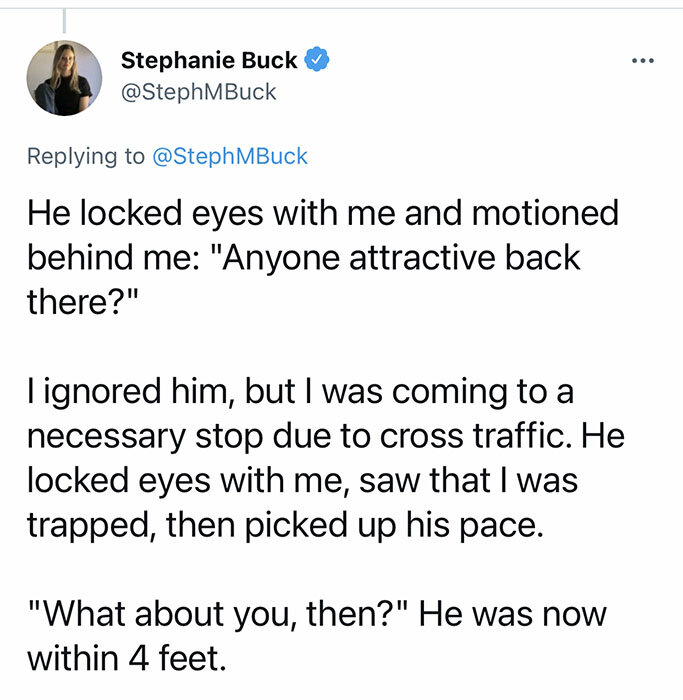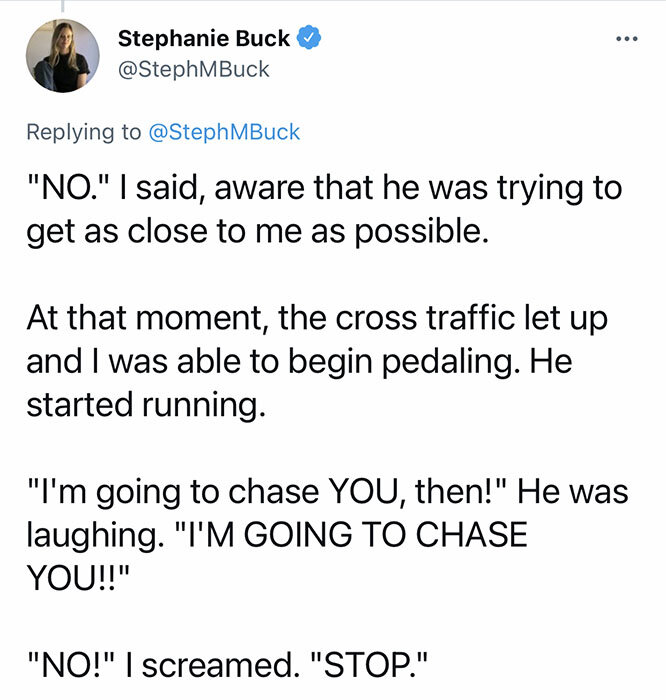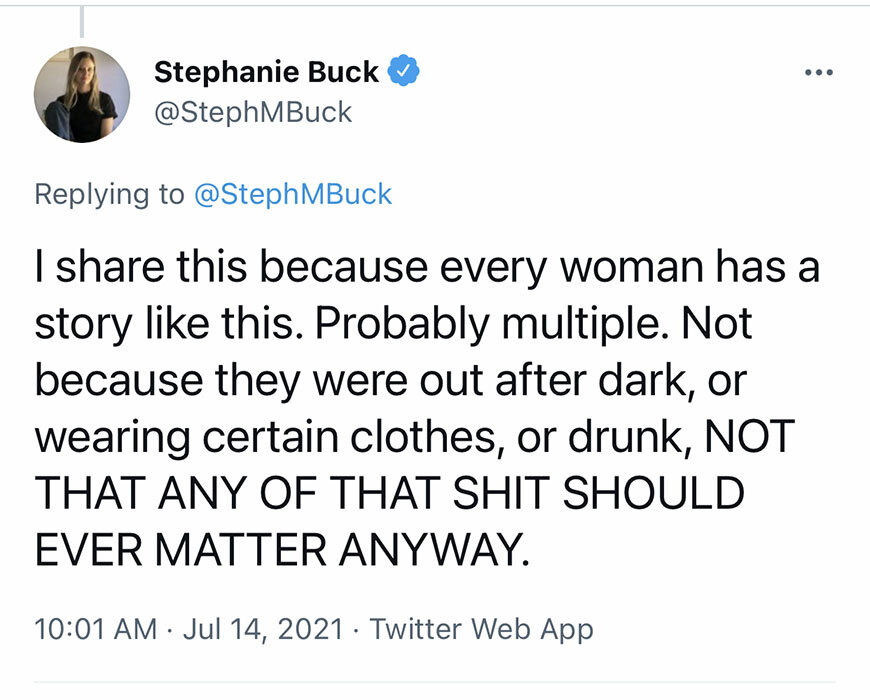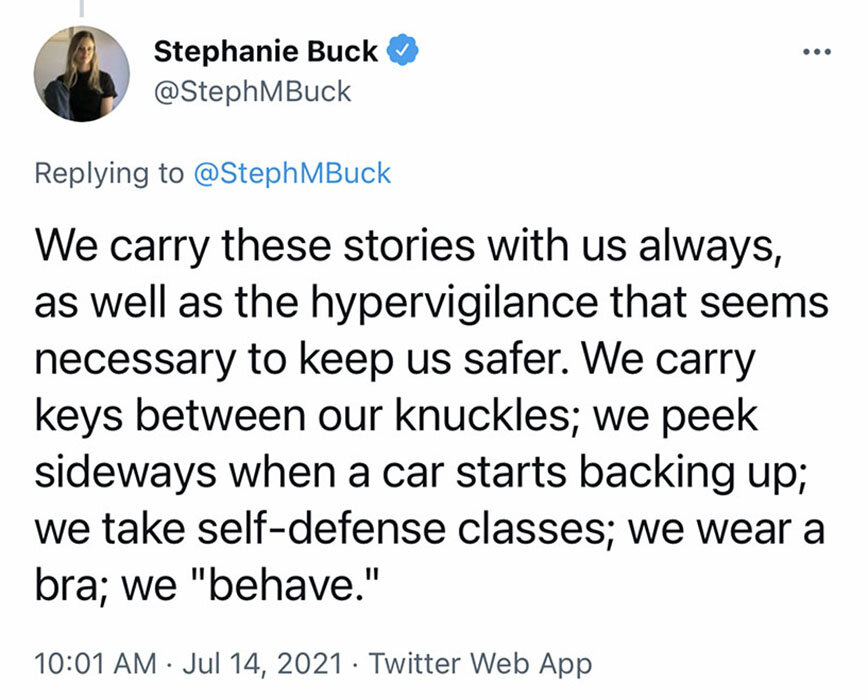Man on the Street: A PSA for Midtown Sacramento
In the past week, two women have taken to social media to share their experiences of being harassed and threatened by men while alone in Midtown Sacramento.
On Wednesday morning, a Sacramento-based journalist shared her personal experience of being harassed and threatened during a recent bike ride in Midtown to her 13.8K Twitter followers. For many women, Stephanie Buck’s account would likely feel at least somewhat familiar.
While taking an early evening ride in the sunlight, Buck stopped her bicycle for car traffic to pass in a populated area of Midtown. When she did, her internal alarm was raised by a man walking by, erratically, who locked eyes with her and tried to engage verbally. She ignored him until he physically approached her, at which point she said, “No.” She started to pedal away when traffic had passed, as he laughed and yelled that he would chase her. He sprinted after her with his arms outstretched until Buck was able to speed up and get enough distance between them. She wrote that, terrified, she got to a safe place and called 911, reporting the incident in a shaky voice.
Two things struck me about Buck’s story. First, it’s an experience so many women relate to, including some who retweeted her thread. “Ugh, this story is unfortunately so relatable for so many of us,” one woman wrote. “I’ve always felt safer when biking, I guess women are never truly safe,” another lamented.
What also struck me was the fact that this was the second time in a week I’d seen a woman take to social media to share her story of being threatened in Midtown. Another Sacramento woman posted in her Instagram stories that, while walking in her neighborhood recently, a man lunged at and spit on her before two women stepped in to help. Shaken, she asked herself: What if they hadn’t been there to help? When Buck got home from her bike ride, she asked herself: What if I hadn’t pedaled fast enough?
It is a shame that women cannot simply walk, bike or exist in public space without worrying about whether or not they are safe. As I tweeted in response to Buck’s story, “Who knows if this is the same guy [in both instances]. I just know it breaks my heart that women can't feel safe simply existing in our community.” It breaks my heart, too, that so many other women and myself know the feeling of being on edge as we navigate the world.
I don’t want this piece to be a how-to for women to keep safe. We should be allowed to wear what we want, act how we want, exist in this world however we want without threat of harm. Period. This is simply a PSA to say that there are men on the street who somehow take delight in scaring and threatening to harm women. Everyone in Midtown, or wherever you may be reading this, stay vigilant. If you feel the need to remove yourself from a situation, trust your gut and, as the women of My Favorite Murder say, Fuck Politeness. Your safety comes first. And if you see something that looks off and think a woman may be harmed, please step in and help her.
I plan to follow up on this piece in the coming days. If you’ve experienced street harassment and would like to speak for the follow-up, please reach out on Twitter at @katejgonzales or via email at katemgonzales3@gmail.com.
Stay tuned and stay safe.
(Screenshots are a selection of Buck’s Twitter thread, used with the author’s permission).
Sacramento, but for who?
Sacramento just got a makeover, courtesy of the Greater Sacramento Economic Council. The organization’s new two-minute commercial is a straightforward appeal to Bay Area families looking to flee to somewhere cheaper, but, we swear, just as hip. It’s a portrait of a city on the rise, complete with amenities for those who can afford it. Think handcrafted lattes, a sophisticated nightlife, toned, sweaty bodies in a gym that resembles a nightclub. Dog parks. Murals. Record shopping. You get it.
What’s missing from this image is obvious to some who already call Sacramento home.
Sacramento just got a makeover, courtesy of the Greater Sacramento Economic Council. The organization’s new two-minute commercial is a straightforward appeal to Bay Area families looking to flee to somewhere cheaper, but, we swear, just as hip. It’s a portrait of a city on the rise, complete with amenities for those who can afford it. Think handcrafted lattes, a sophisticated nightlife, toned, sweaty bodies in a gym that resembles a nightclub. Dog parks. Murals. Record shopping. You get it.
What’s missing from this image is obvious to some who already call Sacramento home.
The colorful “BARK” statue welcoming people to Truitt Bark Park in midtown? In just the last month, I’ve seen a man sleeping at the foot of that statue, another man asking for spare change, and a woman letting her two boys play on the large letters. I later noticed that the small family seemed to be taking a break from living out of their car.
“That commercial was laughable,” said Gabriell Garcia. “It’s a tale of two cities.”
Garcia ran Blue Lamp with her husband, Ben, from 2013 to early 2020. The much-loved venue was known for hosting a range of musical genres and unique local events. The couple was already struggling to pay the bills late last year when the landlord planned to up the rent, nearly tripling it. They couldn’t hold onto the venue, which hosted its final show in December 2019. They took over Café Colonial, an all-ages venue on Stockton Boulevard whose owner also struggled to stay afloat, and were planning shows just before the pandemic hit. Garcia said rent increases have affected other local businesses, like the Hideaway Bar & Grill in Curtis Park, whose owners announced in June that it wouldn’t reopen.
In the time they ran Blue Lamp, which sat on the eastern edge of midtown, Garcia saw surrounding home prices go from $250,000 to $800,000. Next year, Sacramento’s poised to become one of the hottest housing markets in the country, and the city’s affordability compared to the Bay Area is a selling point in GSEC’s commercial.
“You can take that Bay Area-level income and it goes so much farther,” the narrator in the commercial says.
Good for them, but what about the people here who are at a breaking point?
Less than a month before GSEC released its commercial, 63-year-old Greg Tarola was found dead on the streets, wrapped in a wet blanket. According to a CapRadio report, he had recently become homeless.
Meanwhile, those who occupy midtown’s luxury apartments are paying exorbitant prices for the lifestyle that GSEC is selling. Rent at Q19 ranges from $1,800 for a studio to $3,275 for a two-bedroom, two-bathroom unit. According to apartments.com, rent at 1430 Q St. is $2,300 for a one-bedroom and $6,500 for a two-bedroom apartment.
Each year, the number of unhoused Sacramentans is measured through the Point in Time count. The 2019 Homeless Point in Time count found that 5,570 people experience homelessness in the county on a given night, and estimated that 10,000 to 11,000 people experience homelessness annually. And that was before the pandemic.
“You can paint Sacramento however you want to paint it,” Garcia said. “The biggest mistake (the city) is making right now is that it’s alienating the communities and families that have been here for generations.”
Blue Lamp’s marquee with a goodbye message.
Photo courtesy of Cam Evans, @photofromcam on Instagram.
Giving Sacramento a spit shine to attract Bay Area transplants is bad enough, but when Sacramentans voiced their criticism about the ad online, their comments were blocked or removed. The council also removed the video from Twitter, where it received the brunt of residents’ criticism.
The Greater Sacramento Economic Council is selling a lifestyle — one that many working-class residents and people in the creative fields cannot afford.
“I always thought the charm of Sacramento was the quirkiness and jankiness of midtown and the dive bars and the people who built them up,” Garcia said. “[They’re] discrediting the people who have been here.”
Since GSEC removed many of the responses to their ad, I decided to reach out to a few folks in the arts and creative fields to get their perspectives. Here are their responses:
Laura Marie Anthony, founder of Artists of Sacramento (@artistsofsacramento on Instagram)
What’s your overall response to the ad?
To be honest, it didn’t surprise me. Art-washed gentrifying content has been churning out of Sacramento for a while now. When I’m not feeling sickened, numb, or angered by it, my response is to lean into my advocacy work at Artists of Sacramento.
What are some of the issues or barriers for creatives trying to live and advance their careers in Sacramento?Without basic needs met, it’s difficult for creatives to advance their career. Being in constant survival mode is exhausting. Additionally, there isn’t enough respect for the creatives that actually make Sacramento “cool” in the first place. They are usually asked to take very little pay and far too often get offered “exposure” as compensation. All the while those with deep pockets get richer on the backs of their talent. While most creatives learn their worth in the long run, it doesn’t help that predatory people will exploit cheap to free labor from artists who haven’t learned that fact just yet.
Claire White, poet, painter and DSA member
What’s your overall response to the ad?
I understand that the council wants to attract well-off people from the Bay to come to Sacramento. That was my takeaway. It made me feel a little repulsed that the council is investing time, energy, and money into marketing to non-residents all while many people here are struggling to pay their rent and other expenses. I felt disappointed that Sacramento's trend of catering to "elites" takes more precedence than ensuring that actual current residents are able to make ends meet and stay in their houses and other living spaces.
What are some of the issues or barriers or creatives in Sacramento?
The cost of living in California, and especially in Sacramento right now, does not permit a diverse group of people to buy here. I'd like to see The Greater Sacramento Economic Council address how it will support current residents in areas like Oak Park and Del Paso keep their homes. What are they willing to do for people who aren't wealthy or middle class?
Justina Martino, arts administrator and founder of Art Tonic (@art.tonic on instagram)
What’s your overall response to the ad?
I am not opposed to new people moving to Sacramento. I, myself, moved to California from Rhode Island seven years ago. The ad encourages Bay Area folks with large salaries to move to Sacramento, take advantage of the vibrancy created by hard-working Sacramento residents, and not give anything back in return. I was especially turned off by the way the ad encourages people to move here and then spend their dollars in places like Tahoe and Napa. If you encourage people to move to Sacramento, at least encourage them to spend their time and money supporting Sacramento's artists, makers, nonprofit organizations, and small businesses.
What are some of the issues you’ve seen living here that this commercial overlooks?
They say, "Sacramento is creative. Sacramento is vibrant." It is not the city that is creative, it is the residents of the city that are creative. The wording used in this commercial completely ignores the people of Sacramento. The commercial gives credit for the city's creativity to "creative types who were in the Bay Area ten years ago." What??? What about the "creative types" who have grown up in Sacramento, or creatives who have moved to Sacramento from other locations, such as myself, but have put thousands of hours into making Sacramento stronger for little or no pay?
What are some of the big issues or barriers for creatives trying to advance their lives in Sacramento?
There is a lack of affordable housing and safe artist studio spaces in Sacramento. Many of my artist friends have had to relocate multiple times due to rent hikes. With the high price of rent, many artists are unable to afford to rent a studio space in addition to their apartment. Many make due by setting up tiny makeshift art studios at their kitchen tables or in bedroom corners. Some artists have been forced to move into their studio spaces (which are not equipped for living) because they can not afford an apartment. The precarious livelihoods of many Sacramento artists prevents them from realizing their big ideas, stifles their creativity, and prevents them from obtaining opportunities to advance their careers.
If the Greater Sacramento Economic Council is looking to benefit from Sacramento’s creative culture, its staff should listen to the concerns and criticisms of those who have built it. Or at least not hide from their perspectives.







